Mariánské Lázně
Mariánské Lázně (Czech pronunciation: [ˈmarɪjaːnskɛː ˈlaːzɲɛ]; German: Marienbad) is a spa town in the Karlovy Vary Region of the Czech Republic. The town, surrounded by green mountains, is a mosaic of parks and noble houses. Most of its buildings come from the town's Golden Era in the second half of the 19th century, when many celebrities and top European rulers came to enjoy the curative carbon dioxide springs.
Mariánské Lázně | |
|---|---|
Town | |
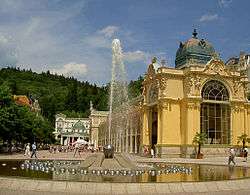 Mariánské Lázně | |
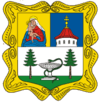 Coat of arms | |
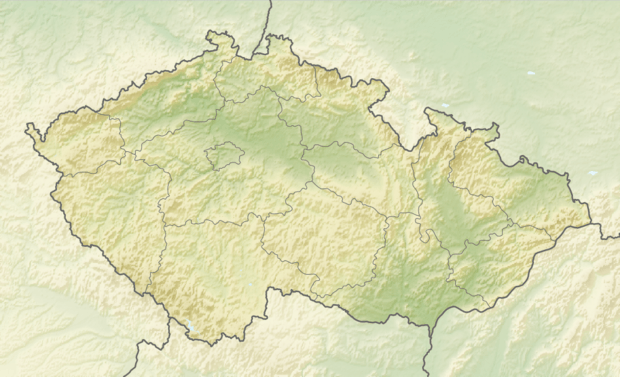 Mariánské Lázně Location in the Czech Republic | |
| Coordinates: 49°57′52″N 12°42′4″E | |
| Country | Czech Republic |
| Region | Karlovy Vary |
| District | Cheb |
| First mentioned | 1273 |
| Government | |
| • Mayor | Martin Kalina |
| Area | |
| • Total | 51.81 km2 (20.00 sq mi) |
| Elevation | 578 m (1,896 ft) |
| Population (2019-01-01[1]) | |
| • Total | 12,800 |
| • Density | 250/km2 (640/sq mi) |
| Time zone | UTC+1 (CET) |
| • Summer (DST) | UTC+2 (CEST) |
| Postal code | 353 01 |
| Website | www.marianskelazne.cz |
History
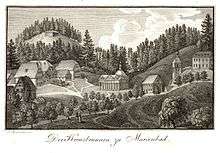
German settlers were called into this region by Bohemian rulers from the Přemyslid dynasty in the 12th Century.
_-_houses_in_center.jpg)
Although the town itself is only about two hundred years old, the locality has been inhabited much longer. The first written record dates back to 1273, when there was a village of Úšovice. The springs first appear in a document dating from 1341 where they are called "the Auschowitzer springs" belonging to the Teplá Abbey. It was only through the efforts of Dr Josef Nehr, the abbey's physician, who from 1779 until his death in 1820 worked hard to demonstrate the curative properties of the springs, that the waters began to be used for medicinal purposes. The place obtained its current name of Marienbad in 1808; became a watering-place in 1818, and received its charter as a town in 1868.[2]
By the early 20th century, approximately 1,000,000 bottles of mineral water were exported annually from Marienbad.[2] The water from the Cross Spring (Kreuzquelle, Křížový pramen) was evaporated and the final product was sold as a laxative under the name of sal teplensis. The modern spa town was founded by the Teplá abbots, namely Karl Kaspar Reitenberger, who also bought some of the surrounding forests to protect them. Under the guidance of gardener Václav Skalník, architect Jiří Fischer, and builder Anton Turner the inhospitable marshland valley was changed into a park-like countryside with colonnades, neoclassical buildings and pavilions around the springs.
The name Marienbad first appeared in 1786; since 1865 it has been a town. Then came a second period of growth, the town's Golden Era. Between 1870 and 1914 many new hotels, colonnades and other buildings, designed by Friedrich Zickler, Josef Schaffer, and Arnold Heymann, were constructed or rebuilt from older houses. In 1872 the town got a railway connection with the town of Cheb (Eger) and thus with the whole Austro-Hungarian Empire and the rest of Europe.
The town soon became one of the top European spas, popular with notable figures and rulers who often returned there. Among them were such names as Johann Wolfgang Goethe, Frédéric Chopin, Thomas Edison, Richard Wagner or Prince Friedrich of Saxony, King Edward VII of the United Kingdom, the Russian Czar Nicholas II, and Emperor Franz Joseph I and many others.[3] At those times, about 20,000 visitors came every year.
Marienbad remained a popular destination between World War I and World War II. After World War II, the ethnic German population of the town was forcibly expelled according to the Potsdam agreement, thereby emptying the town of the majority of its population. After the communist coup-d'état in 1948; it got sealed off from most of its foreign visitors. After the return of democracy in 1989 much effort was put into restoring the town into its original character. Today it is not only a spa town but also a popular holiday resort thanks to its location among the green mountains of the Slavkovský les and the Český les, sport facilities (the town's first golf course was opened in 1905 by the British King Edward VII) and the proximity to other famous spa towns, such as Karlovy Vary (Carlsbad) or Františkovy Lázně (Franzensbad).
Population
Until their expulsion in 1945 the majority of the population of the city spoke German (see Sudetenland). Nowadays, however, most of the inhabitants are Czechs.
| Year | 1869 | 1880 | 1890 | 1900 | 1910 | 1921 | 1930 | 1950 | 1961 | 1970 | 1980 | 1991 | 2001 | 2011 |
|---|---|---|---|---|---|---|---|---|---|---|---|---|---|---|
| Population | 2 582 | 4 075 | 4 942 | 6 424 | 9 123 | 10 183 | 11 794 | 9 261 | 12 882 | 13 559 | 14 930 | 15 382 | 14 741 | 12 906 |
Main sights
Mineral springs and colonnades
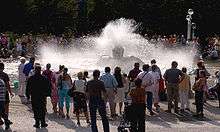
The top attraction of the town is its 100 mineral springs (53 of them are tapped) with high carbon dioxide content and often also higher iron content, both in the town itself and its surroundings. Most of them are well-kept and often pavilions and/or colonnades are built around them. The most notable ones are:
- Křížový pramen (Cross Spring) - is the most famous spring of Mariánské lázně. A monumental pavilion with a cupola bearing a patriarchal cross and 72 Ionic columns was built over the spring in 1818–1826. Today's concrete building is a copy from 1911–1912, originally it was a light wooden and brick construction. The water from the spring is high-mineralized with a strong laxative effect, it has been used for both curative drinks and baths.
- Rudolfův pramen (Rudolph's Spring) - with a wooden pavilion built over the spring, some water is tapped and piped to the nearby colonnade and some is bottled. Its water is low-mineralized with high calcium content and has been used to cure urinary problems.
- Karolinin pramen (Caroline's Spring) - named after the wife of the Emperor Francis I, Caroline Augusta. The nearby colonnade was built in 1869, the pavilion is a reconstruction from 1989. The water is low-mineralized, with higher magnesium content.
- Ferdinandův pramen (Ferdinand's Spring) - the water from the spring, similar in composition to Křížový pramen, is bottled under the Excelsior label.
- Ambrožovy prameny (Ambrose's Springs)
- Lesní pramen (Forest Spring)
- Zpívající fontána (Singing Fountain)
Churches
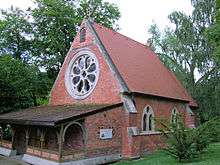
Because of the diverse number of visitors the town is able to maintain churches of several denominations. These include the Anglican Church designed by the notable Victorian architect William Burges and founded by Lady Anna Scott in memory of her husband who died in Mariánské Lázně in 1867. The church was constructed in 1879, shortly before Burges's own death. It is no longer in use as a place of worship and is now a concert hall.
Public transport

The town's public transport is operated mainly by trolleybuses and accompanied by buses servicing the neighbouring villages. There are currently 4 trolleybus lines and 4 bus lines in operation (2016).[5]
The trolleybus system in Mariánské Lázně has been disputed several times since late 1990s by the town's council, claiming high network maintenance costs. Although this is true the current town's representation is looking for ways to keep the system running and asking for state and EU funds to preserve the system. The fact trolleybuses are emission-less makes them more suitable for a spa town than regular polluting buses - or even battery powered buses which are inadequate for a small system with minimal backups due to their low reliability. In addition Mariánské Lázně is one of the smallest towns in the world to operate a trolleybus system and may be viewed as one of the local tourist attractions, rising the value of the town.
Sport
Mariánské Lázně has a very famous motorcycle racing circuit. The venue, a Speedway Longtrack, has hosted six Long Track World Champion finals and five rounds of Grand-Prix racing.
Notable people
- Alex Čejka (born 1970), golfer, born here
- Peter Hofmann (1944–2010), German tenor, born here
- Maurice Loewy (1833–1907), astronomer, born here
- Eduard Petiška (1924–1987), poet and author, died here
- Werner Stark (1909–1985), sociologist and economist, born here
- Fritz Wittmann(born 1933), German politician, born in the locality
A number of notable people visited Mariánské Lázně, among them:[6]
- Edward VII, British King, took annual holidays here
- Johann Wolfgang von Goethe, German writer and statesman
- Frédéric Chopin, Polish composer
- Alfred Nobel, Swedish innovator
- Richard Wagner, German composer
- Friedrich Nietzsche, philosopher
- Franz Joseph I, Austrian Emperor
- Mark Twain, American author
- Emmy Destinn, Czech operatic soprano
- George S. Patton, General of the United States Army
- Winston Churchill, British Prime Minister
- Leonid Shamkovich, Russian chess Grandmaster
Twin towns – sister cities
Mariánské Lázně is twinned with:[7]






Gallery
 Mariánské Lázně – Marienbad Waldmühle 1890
Mariánské Lázně – Marienbad Waldmühle 1890 Mariánské Lázně – Marienbad Belle vue 1890
Mariánské Lázně – Marienbad Belle vue 1890- Royal hotel Nové Lázně – typical spa house in center town
_-_typical_house.jpg) A typical house lost in green canopy
A typical house lost in green canopy_-_colonnade.jpg) The main cast – iron colonnade
The main cast – iron colonnade_-_colonnade_entrance.jpg) The entrance to the main colonnade
The entrance to the main colonnade_-_park_near_Bohemia_hotel.jpg) The central park near Bohemia hotel
The central park near Bohemia hotel
See also
- Marienbad Elegy, a poem by Goethe
- Last Year at Marienbad, a 1961 French film by Alain Resnais
References
- "Population of municipalities of the Czech republic". Czech Statistical Office. Retrieved 30 April 2019.
- Chisholm, Hugh, ed. (1911). . Encyclopædia Britannica. 17 (11th ed.). Cambridge University Press. p. 714.
- Smith, Craig S. (3 July 2007). "This Year at Marienbad, They're Still Taking the Waters". The New York Times. MARIANSKE LAZNE. Retrieved 17 March 2012.
- "Historický lexikon obcí České republiky - 1869 - 2005". The Czech Statistical Office.
- Design, ADENT Web. "Městská doprava Mariánské lázně s.r.o." www.mdml.cz. Archived from the original on 29 July 2016. Retrieved 11 February 2017.
- Edward VII. a František Josef I. se opět setkali v Mariánských Lázních
- "Partnerská města" (in Czech). Město Mariánské Lázně. Retrieved 24 August 2019.
Further reading
| Wikisource has several original texts related to: Mariánské Lázně |
- Norddeutscher Lloyd (1896), "Marienbad", Guide through Germany, Austria-Hungary, Italy, Switzerland, France, Belgium, Holland and England, Berlin: J. Reichmann & Cantor, OCLC 8395555, OL 24839718M
- "Marienbad", Austria-Hungary, Leipzig: K. Baedeker, 1911, OL 18759934M
- Zadoff, Mirjam (2012). Next Year in Marienbad: The Lost Worlds of Jewish Spa Culture. University of Pennsylvania Press. ISBN 978-0-8122-0755-2.
External links
| Wikimedia Commons has media related to Mariánské Lázně. |
| Wikivoyage has a travel guide for Mariánské Lázně. |
- Official tourism website
- Marianske-Lazne.info - Tourist information about Mariánské Lázně
- West bohemian symphony orchestra of Mariánské Lázně
- Mariánské Lázně at Czech.cz
- Municipal website
- Mariánské Lázně - travel guide (basic facts, history, sights, one-day trips)
- History of Mariánské Lázně about history of the town (in Czech)
- Sights and trips in Mariánské Lázně sights and interesting tips for trips (in Marianske Lazne)
- Spa & wellness programs Mariánské Lázně
- Spa & wellness programs Mariánské Lázně - Sights and trips in Mariánské Lázně sights and interesting tips for trips (in Marianske Lazne)